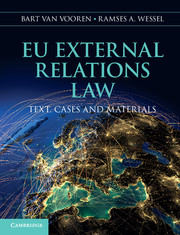Book contents
- Frontmatter
- Contents
- Table of cases
- Table of instruments and legislation
- Preface
- Acknowledgements
- List of abbreviations
- 1 The EU as a global legal actor
- 2 Instruments of EU external action
- 3 Existence of EU external competence
- 4 Nature of EU external competence
- 5 Scope and choice of EU external competence
- 6 The duty of cooperation
- 7 EU law and international law
- 8 The EU and international institutions
- 9 Common Commercial Policy
- 10 EU development policy
- 11 Common Foreign and Security Policy
- 12 Common Security and Defence Policy
- 13 The external dimension of the internal energy market
- 14 The external dimension of freedom, security and justice
- 15 The EU and its neighbours
- Index
- References
1 - The EU as a global legal actor
- Frontmatter
- Contents
- Table of cases
- Table of instruments and legislation
- Preface
- Acknowledgements
- List of abbreviations
- 1 The EU as a global legal actor
- 2 Instruments of EU external action
- 3 Existence of EU external competence
- 4 Nature of EU external competence
- 5 Scope and choice of EU external competence
- 6 The duty of cooperation
- 7 EU law and international law
- 8 The EU and international institutions
- 9 Common Commercial Policy
- 10 EU development policy
- 11 Common Foreign and Security Policy
- 12 Common Security and Defence Policy
- 13 The external dimension of the internal energy market
- 14 The external dimension of freedom, security and justice
- 15 The EU and its neighbours
- Index
- References
Summary
Central issues
This chapter points to the fact that the EU is an international actor. We define this notion as an entity which interacts with third countries and international organizations (and even its own Member States), in ways which are legally and politically distinguishable from its constitutive Member States. In the global context, this entity thus has a stand-alone identity composed of values, interests and policies which it seeks to define and promote internationally as its own.
This chapter then indicates the importance of legal rules in organizing EU international action, and shows that EU external relations law consists of an internal and an external dimension. In its internal dimension it consists of the set of rules which govern the constitutional and institutional legal organization of this legal entity in pursuit of its interests in the world. The external dimension comprises the rules governing the relationship of the EU with the international legal order in which it is active.
In order to study EU external relations law in all its complexity, this chapter provides an overview of the architecture of EU external relations. It outlines the existence of the EU as an international organization with legal personality, which exists legally distinct from its Member States. It also shows that the EU is based on the Treaty on European Union (TEU) and the Treaty on the Functioning of the Union (TFEU), which each contain crucial legal principles constituting the body of EU external relations law.
Finally, in order to be an international actor, the EU needs agents to make the decisions and represent the EU on the global stage. These include the EU institutions, but also other key players in the law of EU external relations.
An international organization or something else?
A textbook on EU external relations law is founded on the premise that the EU can have legal relations with third states and other international organizations. Hence, it is an international actor, with a distinct legal existence just like EU Member States, or international organizations such as the United Nations. What does it mean to say that the EU is an international actor?
- Type
- Chapter
- Information
- EU External Relations LawText, Cases and Materials, pp. 1 - 33Publisher: Cambridge University PressPrint publication year: 2014



